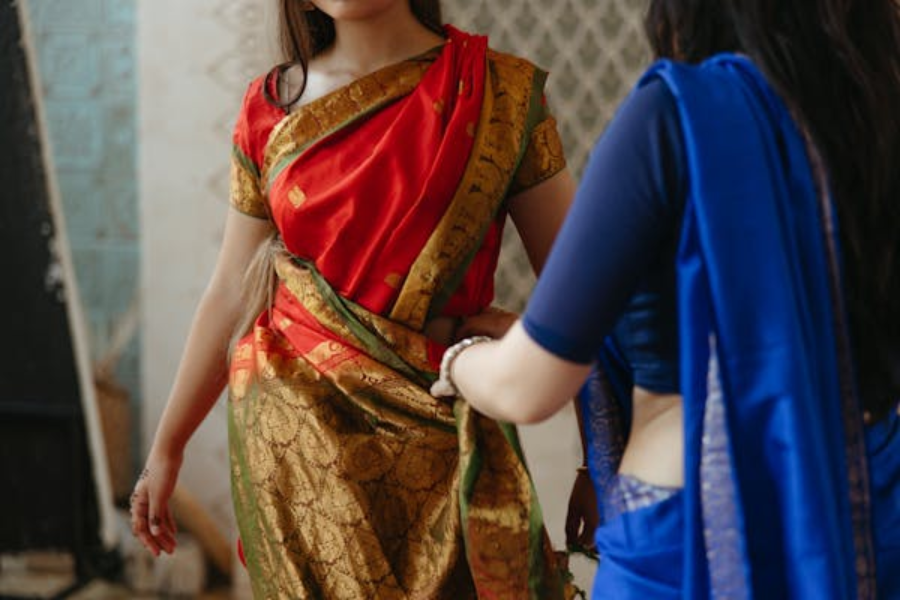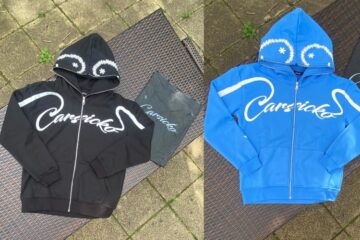The six yards of goodness that every South Asian enjoys and adores is not just a piece of cloth but a versatile drape suitable for any occasion. Women have been wearing sarees for centuries without ever running out of ways to drape them. There are some drape artists who swear by at least a hundred ways to wear a saree without repeating any style. India is a diverse country with various dialects, cooking styles, and cultural practices. The country also boasts a different draping style that is unique to each region. Let’s look at a few regional saree draping styles you must know.
Regional Saree Draping Styles Across India
Nivi, Andhra Pradesh
What we call a “normal” saree drape hails from the state of Andra Pradesh representing the modern-day saree drape that is loved and worn by people across the globe. Although originated in the regions of Andra, this style is no longer local, it has found its way to become the norm that accentuates the curves and sits elegantly on the wearer.
Nauvari Style, Maharashtra
Unlike regular sarees, a Nauvari draping style requires a longer saree, around 9 meters of material as opposed to the traditional 5.5 meters. This long fabric is wrapped around the feet like a makeshift pant or dhoti making it a light and breezy outfit. It makes wearing a saree comfortable for an action-packed day that most Maharashtrian women usually engage in. This style originated as a sensible outfit for women who would go fishing without losing the beauty of traditional attire.
Seedha Pallu, Gujarat
Ubiquitous to the rural women in Gurajrat, the draping style of sarees is similar to the popular drape with the exception of the pallu. The pallu which is usually trailing in the back is brought to the front to cover the bodice. This is also a comfortable draping style for women to move around and do their chores without having to worry about their pallu falling or sliding off.
Mekhela Chadar, Assam
This saree draping style is exclusive to Assamese women and it consists of two different pieces of fabric. The pleated bottom of this draping style – Mekhela – is a continuous loop that’s pleated to make space for the legs to move. Chadar or Sador is the pallu that is also pleated in an asymmetric way over the Mekhela pleats. This saree draping offers a regal look perfect for auspicious and festive occasions.
Coorgi, Karnataka
Coorgi style or Kodagu style was popularised in Coorg, where women wear the pallu by tucking it in their blouse near the shoulder along with a matching head scarf. This style came in style for comfort but now even brides adorn this style with a Kanjivaram silk saree.
Dhangad, Goa
Similar to the Nauvari style, the Dhangad style is also wrapped around the legs in a dhoti style for ultimate comfort and mobility. It only comes up to the knee as Goan women enter the sea and backwaters for fishing and other purposes making the length and drape ideal for staying dry and agile for the day.
Atpoure, Bengal
Traditionally worn by women in Bengal and Bangladesh, this draping style involves the pleats and pallu on both shoulders. In this distinct style, the women of the house tie their house keys on the end of their pallu for safekeeping and to keep the pallu in place with the weight. During Durga Pooja, women wear their traditional red and white saree in the Atpore style with a loud red lip, a big red bindi, and open hair to resonate with Goddess Durga.
Mundum Neriyatum, Kerala
This is the oldest form of saree draping style that still exists in the form of Mundum Neriyatum, where only the bottom half used to be covered with a garment. The Mundu is worn like a lungi and the Neriyatum covers the top with the material tucked into the shoulder. This style is commonly worn by young girls for ease of movement and also during festive occasions reviving traditional cultural practices.
Parsi Drape
As the name suggests, this style is usually worn by Parsi women during family gatherings, and Parsi festivals. It is usually draped with light materials such as georgettes and chiffons, with light jewelry. The draping style brings the pallu to the front like the Seedha pallu but sits diagonally and not perpendicular to the bottom, somewhat inspired by the Nivi drape. This style is also called a Gol drape as it looks like a saree that is wrapped around the body.
Madisar, Tamil Nadu
Traditionally worn by Tamil Brahmin women in ancient India, this saree style is usually draped with a classic Kanjivaram silk with loads of gold jewellery representing opulence and royalty. This style was also adorned by warrior women as the 9 yards of fabric draped the feet for comfort and action similar to a trouser. Today brides from the Iyer and Iyengar communities drape this style to emulate and celebrate their ancestors.
Parting Thoughts
Diversity is a word that doesn’t even begin to capture the essence of India when it comes to food, language, culture, and even sarees. From Bengal to Kerala and Gujarat to Andhra, you will find a different style of draping sarees in every state. With the number of materials, prints, and designs available in sarees, you will never run out of outfit choices.
Keep an eye for more news & updates on Gossips.Blog!




